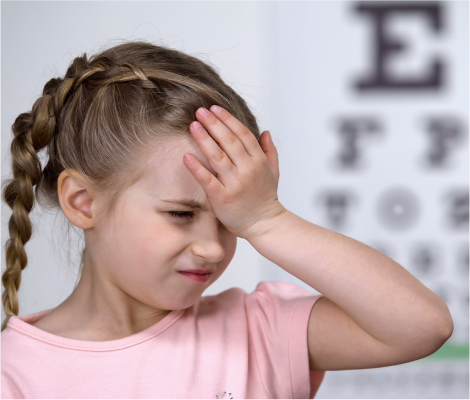University Vision Centre
Myopia Management in El Paso, TX
If so, your child may be at risk for High Myopia and may need Myopia Management. Schedule your Myopia Management Consultation today to learn how to protect your child’s eyes from the effects of myopia.
WHAT IS MYOPIA?
Myopia (also known as nearsightedness) is a condition that occurs when the eye grows too long and causes issues with focusing on objects at a distance. If this condition begins very early in a child’s life, they may be at risk of developing High Myopia.


What is high Myopia?
High Myopia is the level of myopia where the eye’s axial length (length of eye) grows so long that the risk of sight-threatening pathology (retinal detachment, glaucoma, macular degeneration, etc.) increases dramatically.
What are signs that my child may have Myopia?
Signs and symptoms that your child may have Myopia include:
- Being very close to screens and books
- Frequent squinting
- Difficulty seeing/reading at a distance
- Frequent headaches or eyestrain
- Watery eyes


What is Myopia Management?
Myopia Management is a set of different treatments that slow down the elongation of the eye’s axial length to decrease your child’s risk for vision threatening eye diseases in the future. When we slow down the growth of the eye, your child’s prescription will also stop changing rapidly. This allows for your child to maintain clear vision throughout the school year and perform optimally whether academically or in sports/hobbies.
These treatments include:
Orthokeratology
Multifocal Soft Contact Lenses
Low-dose Atropine Eye Drops
Controlling 1D of myopia can reduce the risk of maculopathy by 40%. Reducing the rate of myopia progression by 50% could reduce the prevalence of high myopia by 90%.
DON’T LET MYOPIA IMPACT YOUR CHILD’S LIFE
Myopia can hinder children as they’re developing, particularly at school, during sports, and when making friends. Eyeglasses can correct their vision temporarily, but they don’t address the underlying issue. Don’t let myopia blur the lines for your child! Dr. Davila at University Vision Centre searches for signs of myopia during his pediatric eye exams, then takes steps to keep it in check with his customized myopia management program.
What is Axial Length?
Measuring Axial Length is considered the Gold Standard for Myopia monitoring. At University Vision Centre, we use advanced technology to measure this length to assess for risk of disease and to monitor Myopia progression in your child at the highest level possible.
How do I prevent my child from developing High Myopia?
How can I determine if my child is at risk for High myopia?
What causes High Myopia?
Several factors contribute to the early onset of Myopia and the development of High Myopia. Genetics and behavioral risk factors are the strongest contributors to the development of High Myopia.
Behavioral risk factors include:
- Increased computer use
- Cell phone use
- Handheld game use
- Limited time outdoors
WHY CHOOSE UNIVERSITY VISION CENTRE FOR MYOPIA MANAGEMENT?

Myopia Management
in El Paso
If you are concerned that your child may be nearsighted, don’t wait; schedule a pediatric eye exam today. We will walk you through our process, and tailor a plan to manage your child’s myopia, no matter what language you speak or where in El Paso and beyond you come from!
Eastside Location
Westside Location
Let’s Start a Conversation
"*" indicates required fields

